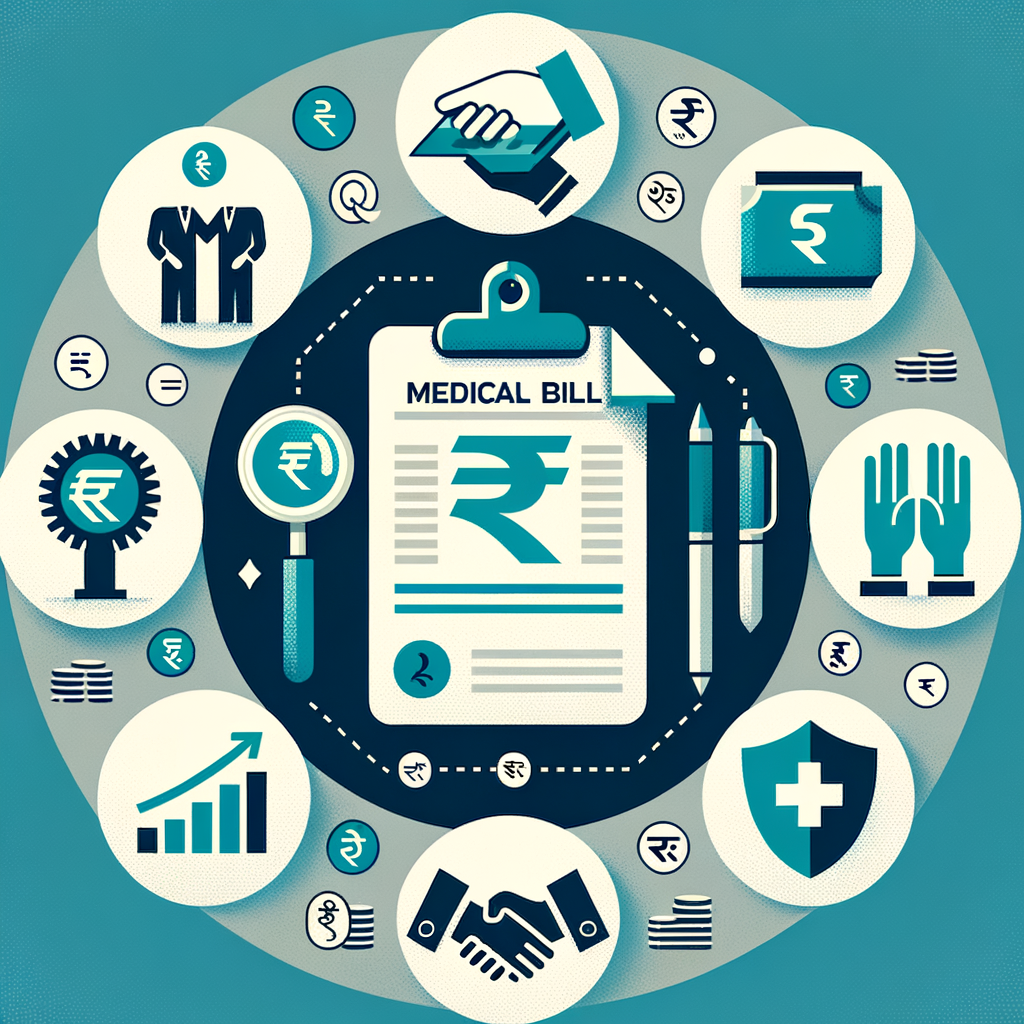Managing Medical Bills and Debt: A Practical Guide
A sudden medical emergency is one of life’s most stressful events. The immediate worry for a loved one’s health is quickly followed by another daunting challenge: a mountain of complex, confusing paperwork. For families across India, the stress of a health crisis is often compounded by the financial strain that follows. This is where a clear plan for managing medical bills becomes not just helpful, but essential for your peace of mind and financial stability. This comprehensive guide will provide you with clear, actionable steps to navigate hospital billing, maximize your insurance claims, and effectively manage any resulting debt. It is designed to empower you with the knowledge to take control of your finances during these challenging times.
First Things First: Understanding Your Medical Bills in India
The first step towards taking control is to demystify the bill itself. A thick stack of papers with medical jargon can be intimidating, but with a systematic approach, you can ensure you are only paying for what you should. A key part of understanding medical bills in India is to move beyond the summary and dig into the details.
Always Demand an Itemized Bill
When a patient is discharged, hospitals often provide a consolidated summary bill. This document gives you the total amount but offers little insight into the specific charges. It is your right as a consumer to demand a detailed, itemized bill. This version breaks down every single cost incurred during the hospital stay, from a simple cotton swab to a major surgical procedure. An itemized bill is the only tool that allows you to properly verify charges, spot potential errors, and contest any discrepancies. Without it, you are essentially flying blind and may end up paying for services you never received.
Common Components of a Hospital Bill to Review
Once you have the itemized bill, focus your attention on these key areas. Scrutinizing each component is one of the most effective tips for managing medical bills in India.
- Room Rent: Hospital rooms come in various categories (e.g., general ward, semi-private, private, deluxe suite), and the rent varies significantly. Crucially, many other charges, like doctor’s consultation fees and nursing charges, are often linked to your room category. Ensure you were billed for the correct room type for the entire duration of your stay.
- Doctor/Consultant Fees: This section should list every visit from your primary doctor and any other specialists. Cross-check the number of visits charged against the actual number of times the doctor saw the patient. Verify that the fees align with the standard rates for the consultant and the room category.
- Pharmacy & Consumables: This can be a major source of overcharging. Meticulously review the list of medicines and medical supplies. Check for any medicines that were not prescribed or administered. Also, compare the prices of branded medicines and devices against their MRP (Maximum Retail Price), as hospitals cannot legally charge more than the MRP.
- Investigation & Lab Charges: Every blood test, X-ray, MRI, or other diagnostic procedure should be listed here. Tally these charges with the actual tests that were conducted and ensure you have received a report for every single investigation you were billed for.
How to Spot Errors and Overcharges
Armed with your itemized bill and medical records, look for these common billing mistakes:
- Duplicate Charges: Being billed twice for the same test, medicine, or procedure.
- Services Not Rendered: Charges for a consultation that never happened or a test that was cancelled.
- Incorrect Billing for Room Type: Being charged for a private room when the patient was in a semi-private room.
- Phantom Charges: Vague items listed as “miscellaneous” or “service charges” without proper justification.
- Timing Errors: Charges for services dated before admission or after discharge.
- Upcoding: Billing for a more expensive procedure or treatment than what was actually performed.
If you find any discrepancies, immediately bring them to the attention of the hospital’s billing department with your supporting evidence.
Leveraging Health Insurance to Minimize Your Burden
Your health insurance policy is your primary financial shield against high medical costs. Understanding how to use it effectively is crucial for minimizing your out-of-pocket expenses.
Cashless vs. Reimbursement: Knowing the Process
There are two primary ways to make a health insurance claim. Knowing the difference helps you prepare for the process and choose the best option for your situation.
| Feature | Cashless Claim | Reimbursement Claim |
|---|---|---|
| How it Works | The hospital directly settles the bill with your insurer via a TPA (Third-Party Administrator). | You pay the hospital bill first and then apply to your insurer for a refund. |
| Convenience | High. No need to arrange for large sums of cash. | Low. Requires you to have funds available to pay the full amount upfront. |
| Hospital Choice | Limited to the insurer’s network of hospitals. | You can choose any hospital, including non-network ones. |
| Paperwork | Managed primarily between the hospital and the TPA. | You are responsible for collecting all bills, reports, and receipts to submit. |
| Best For | Planned hospitalizations and emergencies in network hospitals. | Treatment in a non-network hospital or when cashless approval is delayed/denied. |
Read the Fine Print: Exclusions, Sub-limits, and Co-payments
The effectiveness of your insurance policy depends on its terms and conditions. It’s vital to review your policy document, preferably before an emergency arises. Pay close attention to:
- Exclusions: These are specific treatments, procedures, or conditions that your policy does not cover at all (e.g., cosmetic surgery, pre-existing diseases within the waiting period).
- Sub-limits: Your insurer may place a cap on the amount they will pay for certain expenses, even if your total sum insured is much higher. For example, your policy might have a sub-limit on room rent, capping it at ₹5,000 per day. If you choose a room that costs ₹8,000, you must pay the ₹3,000 difference out-of-pocket for every day of your stay.
- Co-payment: This is a clause where you agree to pay a certain percentage of the total claim amount yourself. For instance, a 10% co-payment on a ₹2 lakh bill means you pay ₹20,000, and the insurer pays the remaining ₹1.8 lakhs.
What to Do if Your Insurance Claim is Rejected
A claim rejection can be incredibly disheartening, but it’s not always the final word. Follow this structured process to appeal the decision:
- Understand the Reason: First, get a formal communication from your insurer stating the exact reason for the rejection in writing. It could be due to incomplete paperwork, a policy exclusion, or a misinterpretation of the terms.
- Contact the Grievance Redressal Officer (GRO): Every insurance company has a designated GRO. Write to them, explaining your case clearly and providing any missing documents or clarifications they might need.
- Approach the Insurance Ombudsman: If you don’t receive a satisfactory response from the insurer’s GRO within a reasonable time, you can escalate the issue to the Insurance Ombudsman. This is an independent body that resolves disputes between policyholders and insurers.
For detailed information on the grievance process, you can visit the IRDAI’s official resolution portal: Bima Bharosa Portal.
A Practical Guide for Medical Debt in India: Strategies to Take Control
Even with insurance, significant out-of-pocket expenses can lead to debt. This section provides a practical guide for medical debt in India, offering strategies on how to manage medical debt in India without letting it spiral out of control.
Don’t Be Afraid to Negotiate with the Hospital
Many people are unaware that hospital bills can sometimes be negotiated, especially the portion not covered by insurance. Most hospitals have a billing department or a patient welfare office that is authorized to discuss payment terms. Approach them calmly and professionally. If you found clear errors during your bill review, use them as a starting point. You can also inquire about discounts for making a prompt, lump-sum payment for the outstanding amount. Explain your financial situation honestly; some hospitals may be willing to waive certain charges or offer a discount on compassionate grounds.
Explore Structured Payment Options
If paying a large sum at once isn’t feasible, don’t resort to high-interest personal loans immediately. First, explore more structured and potentially lower-cost options.
- In-house EMIs: Many large hospital chains have tie-ups with financial institutions or offer their own payment plans. These can sometimes be interest-free or come with very low processing fees, making them a much more affordable option than external loans. Always ask the hospital’s billing desk about any available EMI schemes.
- Third-party Financing: If the hospital doesn’t offer an in-house plan, you can consider other options. A dedicated medical loan from a bank or NBFC is one possibility. Alternatively, you can use your credit card and convert the large payment into EMIs. While these options provide immediate liquidity, be very careful about the interest rates and repayment terms, as they can add significantly to your overall cost.
Check Your Eligibility for Government Health Schemes
The Indian government runs several health schemes to provide financial protection to its citizens, especially the economically weaker sections. The most prominent among these is the Ayushman Bharat Pradhan Mantri Jan Arogya Yojana (PM-JAY). This scheme provides health coverage of up to ₹5 lakh per family per year for secondary and tertiary care hospitalization. Eligibility is typically based on the socio-economic and caste census data. It’s always worthwhile to check if your family is covered under this or any state-specific health schemes. You can check your eligibility on the official PM-JAY portal.
Finding Financial Relief: Tax Benefits on Medical Expenses
While you focus on clearing bills, don’t forget that the Indian Income Tax Act offers several deductions that can provide some financial relief. Claiming these benefits is a smart way of managing medical bills post-facto.
Section 80D: Deductions for Health Insurance Premiums
This is the most common tax benefit related to health. Under Section 80D, you can claim a deduction for the health insurance premiums you pay for yourself, your spouse, your dependent children, and your parents.
- For Self, Spouse, and Dependent Children: Up to ₹25,000 per year.
- For Parents (below 60 years): An additional deduction of up to ₹25,000.
- For Parents (Senior Citizens, 60 years or above): The additional deduction limit increases to ₹50,000.
- Preventive Health Check-up: Within these overall limits, you can claim a deduction of up to ₹5,000 for preventive health check-ups.
Section 80DDB: Tax Relief for Treatment of Specified Diseases
If you or a dependent family member are undergoing treatment for certain specified critical illnesses (like cancer, chronic renal failure, or neurological diseases), you can claim a deduction for the medical expenses incurred under Section 80DDB.
- For individuals below 60 years: Up to ₹40,000 per year.
- For senior citizens (60 years or above): The deduction limit increases to ₹1,00,000 per year.
The Importance of Keeping Meticulous Records
To claim any of these tax deductions, you must have proof. The Income Tax Department requires you to maintain proper documentation to substantiate your claims. It is absolutely essential to save all original hospital bills, pharmacy receipts, doctor’s prescriptions, and diagnostic reports. These documents are mandatory and will be needed when you file your income tax return. Keeping a dedicated file for all medical-related paperwork throughout the year will make the tax filing process much smoother. For official rules and details, you can always refer to the Income Tax Department of India website.
Conclusion
A medical crisis is an emotionally and financially draining experience. However, by taking a proactive and informed approach, you can significantly reduce the financial burden. The key pillars of managing medical bills effectively are straightforward:
- Verify: Always demand an itemized bill and scrutinize every single charge for errors.
- Utilize: Understand your health insurance policy inside out to maximize your claim and minimize out-of-pocket costs.
- Communicate: Don’t hesitate to negotiate with the hospital for discounts or explore structured payment plans like EMIs.
- Claim: Remember to leverage the available income tax deductions on medical expenses to get some financial relief.
While medical emergencies are often unavoidable, the resulting financial distress doesn’t have to be. By being prepared and knowledgeable, you can navigate this difficult period with greater confidence and focus on what truly matters—recovery and well-being.
Navigating medical bills and tax claims can be complex. Let the experts at TaxRobo help you manage your finances and maximize your tax savings. Contact us today for a consultation on tax filing and financial planning.
FAQs (Frequently Asked Questions)
Q1: Can the hospital charge more than the MRP on medicines and medical devices?
Answer: No, hospitals cannot charge more than the Maximum Retail Price (MRP) printed on the product. It is illegal to do so. If you find any discrepancies where the billed amount is higher than the MRP, you have the right to challenge the charge and demand a correction from the hospital’s billing department.
Q2: What is a TPA (Third-Party Administrator) and what is their role?
Answer: A TPA is an intermediary organization appointed by an insurance company to handle all claim-related processing on its behalf. Their role includes issuing insurance cards, facilitating cashless approvals at network hospitals, processing paperwork, and settling reimbursement claims. They essentially act as a bridge between you, the hospital, and your insurance provider to streamline the claims process.
Q3: Are expenses from alternative treatments like Ayurveda or Homeopathy covered by health insurance?
Answer: This depends entirely on your specific insurance policy. In the past, most policies did not cover alternative treatments. However, many modern health insurance policies now include coverage for AYUSH (Ayurveda, Yoga & Naturopathy, Unani, Siddha, and Homeopathy) treatments, provided the treatment is taken at a government-recognized hospital or centre. You must check your policy terms and conditions to confirm if AYUSH treatments are covered.
Q4: What documents are essential for claiming medical expenses under Section 80DDB?
Answer: To claim a deduction under Section 80DDB for the treatment of specified critical illnesses, you need two primary documents. First, you need the actual bills and receipts for the medical expenses incurred. Second, you must have a prescription or a certificate from a qualified specialist doctor (e.g., an Oncologist for cancer or a Neurologist for neurological ailments) confirming the disease, as prescribed under Rule 11DD of the Income Tax Rules.



